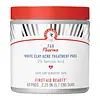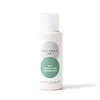What's inside
What's inside
 Key Ingredients
Key Ingredients

 Benefits
Benefits

 Concerns
Concerns

 Ingredients Side-by-side
Ingredients Side-by-side

Salicylic Acid
MaskingWater
Skin ConditioningPolysorbate 80
EmulsifyingPhenoxyethanol
PreservativeSodium Hydroxide
BufferingGlycerin
HumectantSodium Citrate
BufferingKaolin
AbrasiveSalix Nigra Bark Extract
Skin ProtectingRosmarinus Officinalis Leaf Oil
MaskingButylene Glycol
HumectantPotassium Sorbate
PreservativeSodium Benzoate
MaskingCamellia Sinensis Leaf Extract
AntimicrobialChrysanthemum Parthenium Extract
Skin ConditioningGlycyrrhiza Glabra Root Extract
BleachingCapryloyl Glycine
CleansingHexylene Glycol
EmulsifyingMelaleuca Alternifolia Leaf Oil
AntioxidantSarcosine
Skin ConditioningLeuconostoc/Radish Root Ferment Filtrate
AntimicrobialEnantia Chlorantha Bark Extract
Skin ConditioningEpilobium Angustifolium Flower/Leaf/Stem Extract
Skin ConditioningCinnamomum Zeylanicum Bark Extract
AntimicrobialXanthan Gum
EmulsifyingLimonene
PerfumingOleanolic Acid
Skin ConditioningSalicylic Acid, Water, Polysorbate 80, Phenoxyethanol, Sodium Hydroxide, Glycerin, Sodium Citrate, Kaolin, Salix Nigra Bark Extract, Rosmarinus Officinalis Leaf Oil, Butylene Glycol, Potassium Sorbate, Sodium Benzoate, Camellia Sinensis Leaf Extract, Chrysanthemum Parthenium Extract, Glycyrrhiza Glabra Root Extract, Capryloyl Glycine, Hexylene Glycol, Melaleuca Alternifolia Leaf Oil, Sarcosine, Leuconostoc/Radish Root Ferment Filtrate, Enantia Chlorantha Bark Extract, Epilobium Angustifolium Flower/Leaf/Stem Extract, Cinnamomum Zeylanicum Bark Extract, Xanthan Gum, Limonene, Oleanolic Acid
Water
Skin ConditioningPolyglyceryl-4 Caprate
EmulsifyingGlycerin
HumectantSalicylic Acid
MaskingSalix Nigra Bark Extract
Skin ProtectingSodium Hyaluronate
HumectantCentella Asiatica Extract
CleansingSqualane
EmollientCaffeine
Skin ConditioningTilia Cordata Flower Extract
Skin ConditioningLitsea Cubeba Fruit Oil
MaskingCitrus Nobilis Peel Oil
MaskingCitrus Grandis Peel Oil
MaskingCananga Odorata Flower Oil
MaskingLavandula Angustifolia Flower Oil
MaskingTocopherol
AntioxidantPotassium Sorbate
PreservativeSodium Benzoate
MaskingSodium Hydroxide
BufferingDehydroacetic Acid
PreservativeBenzyl Alcohol
PerfumingFarnesol
PerfumingLimonene
PerfumingLinalool
PerfumingCitral
PerfumingBenzyl Benzoate
AntimicrobialGeraniol
PerfumingBenzyl Salicylate
PerfumingWater, Polyglyceryl-4 Caprate, Glycerin, Salicylic Acid, Salix Nigra Bark Extract, Sodium Hyaluronate, Centella Asiatica Extract, Squalane, Caffeine, Tilia Cordata Flower Extract, Litsea Cubeba Fruit Oil, Citrus Nobilis Peel Oil, Citrus Grandis Peel Oil, Cananga Odorata Flower Oil, Lavandula Angustifolia Flower Oil, Tocopherol, Potassium Sorbate, Sodium Benzoate, Sodium Hydroxide, Dehydroacetic Acid, Benzyl Alcohol, Farnesol, Limonene, Linalool, Citral, Benzyl Benzoate, Geraniol, Benzyl Salicylate
Ingredients Explained
These ingredients are found in both products.
Ingredients higher up in an ingredient list are typically present in a larger amount.
Glycerin is already naturally found in your skin. It helps moisturize and protect your skin.
A study from 2016 found glycerin to be more effective as a humectant than AHAs and hyaluronic acid.
As a humectant, it helps the skin stay hydrated by pulling moisture to your skin. The low molecular weight of glycerin allows it to pull moisture into the deeper layers of your skin.
Hydrated skin improves your skin barrier; Your skin barrier helps protect against irritants and bacteria.
Glycerin has also been found to have antimicrobial and antiviral properties. Due to these properties, glycerin is often used in wound and burn treatments.
In cosmetics, glycerin is usually derived from plants such as soybean or palm. However, it can also be sourced from animals, such as tallow or animal fat.
This ingredient is organic, colorless, odorless, and non-toxic.
Glycerin is the name for this ingredient in American English. British English uses Glycerol/Glycerine.
Learn more about GlycerinLimonene is a fragrance that adds scent and taste to a formulation.
It's found in the peel oil of citrus fruits and other plants such as lavender and eucalyptus. The scent of limonene is generally described as "sweet citrus".
Limonene acts as an antioxidant, meaning it helps neutralize free radicals.
When exposed to air, oxidized limonene may sensitize the skin. Because of this, limonene is often avoided by people with sensitive skin.
The term 'fragrance' is not regulated in many countries. In many cases, it is up to the brand to define this term. For instance, many brands choose to label themselves as "fragrance-free" because they are not using synthetic fragrances. However, their products may still contain ingredients such as essential oils that are considered a fragrance.
Learn more about LimonenePotassium Sorbate is a preservative used to prevent yeast and mold in products. It is commonly found in both cosmetic and food products.
This ingredient comes from potassium salt derived from sorbic acid. Sorbic acid is a natural antibiotic and effective against fungus.
Both potassium sorbate and sorbic acid can be found in baked goods, cheeses, dried meats, dried fruit, ice cream, pickles, wine, yogurt, and more.
You'll often find this ingredient used with other preservatives.
Learn more about Potassium SorbateSalicylic Acid (also known as beta hydroxy acid or BHA) is a well-known ingredient for treating skin that struggles with acne and clogged pores. It exfoliates both the skin's surface and deep within the pores to help clear out buildup, control oil, and reduce inflammation.
Unlike AHAs (alpha hydroxy acids), salicylic acid is oil-soluble. This allows it to penetrate into pores which makes it especially effective for treating blackheads and preventing future breakouts.
Salicylic acid is also known for its soothing properties. It has a similar structure to aspirin and can calm inflamed or irritated skin, making it a good option for acne-prone skin that is also sensitive.
Concentrations of 0.5-2% are recognized by the U.S. FDA as an over-the-counter topical acne product.
It can cause irritation and/or dryness if one's skin already has a compromised moisture barrier, so it's best to focus on repairing that before introducing this ingredient into your routine.
While salicylic acid does not increase sun sensitivity, it’s still important to wear sunscreen daily to protect your skin.
If you are looking for the ingredient called BHA or Butylated Hydroxyanisole, click here.
Learn more about Salicylic AcidWe don't have a description for Salix Nigra Bark Extract yet.
Sodium Benzoate is a preservative. It's used in both cosmetic and food products to inhibit the growth of mold and bacteria. It is typically produced synthetically.
Both the US FDA and EU Health Committee have approved the use of sodium benzoate. In the US, levels of 0.1% (of the total product) are allowed.
Sodium benzoate works as a preservative by inhibiting the growth of bacteria inside of cells. It prevents the cell from fermenting a type of sugar using an enzyme called phosphofructokinase.
It is the salt of benzoic acid. Foods containing sodium benzoate include soda, salad dressings, condiments, fruit juices, wines, and snack foods.
Studies for using ascorbic acid and sodium benzoate in cosmetics are lacking, especially in skincare routines with multiple steps.
We always recommend speaking with a professional, such as a dermatologist, if you have any concerns.
Learn more about Sodium BenzoateSodium Hydroxide is also known as lye or caustic soda. It is used to adjust the pH of products; many ingredients require a specific pH to be effective.
In small amounts, sodium hydroxide is considered safe to use. However, large amounts may cause chemical burns due to its high alkaline.
Your skin has a natural pH and acid mantle. This acid mantle helps prevent harmful bacteria from breaking through. The acid mantle also helps keep your skin hydrated.
"Alkaline" refers to a high pH level. A low pH level would be considered acidic.
Learn more about Sodium HydroxideWater. It's the most common cosmetic ingredient of all. You'll usually see it at the top of ingredient lists, meaning that it makes up the largest part of the product.
So why is it so popular? Water most often acts as a solvent - this means that it helps dissolve other ingredients into the formulation.
You'll also recognize water as that liquid we all need to stay alive. If you see this, drink a glass of water. Stay hydrated!
Learn more about Water